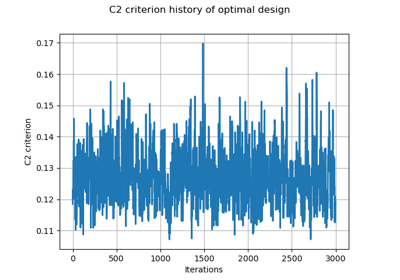SpaceFillingMinDist¶
- class SpaceFillingMinDist(*args)¶
Space filling minimal distance criterion.
Notes
Compute the criterion based on the minimal distance of sample points:
Methods
evaluate(sample)Compute the MinDist criterion for a specific design.
Accessor to the object's name.
getId()Accessor to the object's id.
getName()Accessor to the object's name.
Accessor to the object's shadowed id.
Accessor to the object's visibility state.
hasName()Test if the object is named.
Test if the object has a distinguishable name.
Minimization flag accessor.
perturbLHS(oldDesign, oldCriterion, row1, ...)Elementary perturbation.
setName(name)Accessor to the object's name.
setShadowedId(id)Accessor to the object's shadowed id.
setVisibility(visible)Accessor to the object's visibility state.
- __init__(*args)¶
- evaluate(sample)¶
Compute the MinDist criterion for a specific design.
- Parameters:
- design
Sampleor 2-d array like The design
- design
- Returns:
- critfloat
The MinDist criterion
Examples
>>> import openturns as ot >>> # Build an LHS using openturns class >>> lhs = ot.LHSExperiment(ot.Uniform(), 100) >>> design = lhs.generate() >>> # Compute the MinDist criterion >>> crit = ot.SpaceFillingMinDist().evaluate(design)
- getClassName()¶
Accessor to the object’s name.
- Returns:
- class_namestr
The object class name (object.__class__.__name__).
- getId()¶
Accessor to the object’s id.
- Returns:
- idint
Internal unique identifier.
- getName()¶
Accessor to the object’s name.
- Returns:
- namestr
The name of the object.
- getShadowedId()¶
Accessor to the object’s shadowed id.
- Returns:
- idint
Internal unique identifier.
- getVisibility()¶
Accessor to the object’s visibility state.
- Returns:
- visiblebool
Visibility flag.
- hasName()¶
Test if the object is named.
- Returns:
- hasNamebool
True if the name is not empty.
- hasVisibleName()¶
Test if the object has a distinguishable name.
- Returns:
- hasVisibleNamebool
True if the name is not empty and not the default one.
- isMinimizationProblem()¶
Minimization flag accessor.
- Returns:
- isMinimizationbool
Whether the problem is a minimization.
- perturbLHS(oldDesign, oldCriterion, row1, row2, column)¶
Elementary perturbation.
- Parameters:
- design
Sample The design to perturb (in-place)
- oldCriterionfloat
The previous value of the criterion
- row1int
First row index
- row2int
Second row index
- design
- Returns:
- criterionfloat
The value of the criterion
- setName(name)¶
Accessor to the object’s name.
- Parameters:
- namestr
The name of the object.
- setShadowedId(id)¶
Accessor to the object’s shadowed id.
- Parameters:
- idint
Internal unique identifier.
- setVisibility(visible)¶
Accessor to the object’s visibility state.
- Parameters:
- visiblebool
Visibility flag.
 OpenTURNS
OpenTURNS
